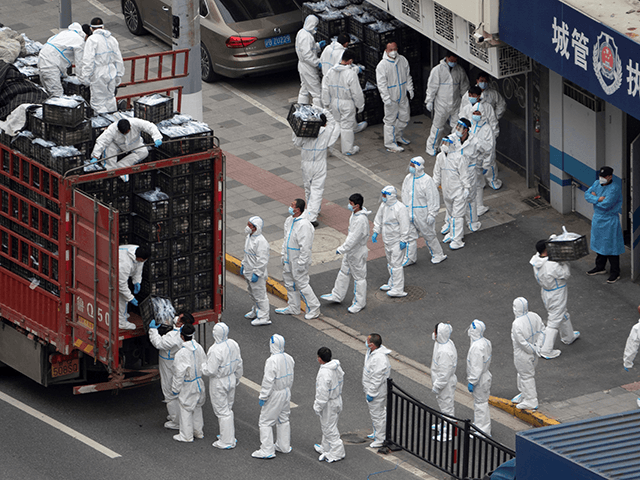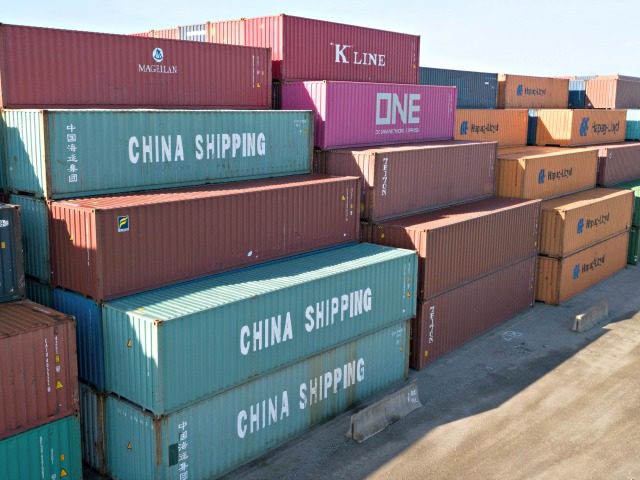Chinese state media on Wednesday grudgingly admitted coronavirus lockdowns are causing serious problems with domestic distribution and international shipping, as new data revealed imports unexpectedly collapsed by almost 16 percent last month.
China’s imports grew 15.5 percent in January and February amid worldwide pandemic recovery, and analysts were predicting at least 8 percent growth in March – but instead, they saw a 0.1 percent decline.
“China’s export growth stayed strong in March, but imports collapsed. The weak imports likely reflect the damage from Omicron outbreaks that slowed the flow of goods through major ports in China. As imports in March reflect orders placed in earlier months, this is probably not driven by weakening demand,” Pinpoint Asset Management chief economist Zhang Zhiwei said.
Zhang anticipated weak imports through at least May, possibly with further reductions in April, as “supply-chain disruptions have an adverse impact on industrial production.”
China’s state-run Global Times on Tuesday admitted coronavirus lockdowns are causing “disruptions in logistics and delayed shipments,” although the report sought to minimize the problem, assuring readers that normal shipping would surely resume once a few days of mass nucleic acid testing for the Wuhan coronavirus were completed.
The Global Times quoted various corporate employees who said “stagnant logistics” were reducing demand and thwarting the fulfillment of orders in the electronics hub of Suzhou. Some of these interviewees cited coronavirus lockdowns as a “major hurdle” since trucks are not able to travel freely between cities to pick up cargo.
Another Global Times article on Tuesday blamed import problems on “sluggish global demand driven by the slow recovery from the COVID-19 [Chinese coronavirus] pandemic, surging US inflation, the Russia-Ukraine conflict” and “high U.S. interest rates” in addition to “COVID-19 flare-ups in some parts of China.”
“The epidemic in Shanghai is also affecting trade flows. Although the Shanghai port, the world’s largest container port, is still operating, regional lockdowns and traffic closures in neighboring areas are making deliveries difficult,” the article grudgingly admitted.
The Global Times predicted shipping problems would be quickly resolved, thanks to measures such as orders to avoid highway, port, railroad, or airport shutdowns that would prevent cargo from moving promptly.
No explanation was provided for how this could be done without compromising China’s highly-touted “dynamic zero-Covid” lockdown strategy. Not long ago, China was blaming infected cargo from North America for bringing the coronavirus back to its shores.
Also, on Tuesday, the Global Times touted Chinese government agencies for “doubling down on efforts to unclog transport and logistics.”
“Such commitments, adding to a slew of weighty policy announcements over recent days, are envisioned to troubleshoot logistics artery blockages that have lately weighed on economic activities,” the Global Times asserted.
This second article regaled readers with details of all the meetings scheduled by important government ministers to discuss logistical problems, making numerous references to “last kilometer” delivery guarantees, which sounds like a way to reassure terrified victims of the Shanghai lockdown they will not be left without food and medicine for much longer.
“With the expeditious solutions indicating a more sophisticated push for balancing the country’s virus containment efforts and its economic functioning, hopes are high that those calling into question the zero-Covid strategy ought to be convinced of the country’s capabilities of striking a compelling balance,” the Global Times chirped, serenely ignoring the desperate online cries for help from Shanghai.
Both the Global Times and the state-run Xinhua news service labored to portray foreign concerns about the humanitarian impact of China’s lockdowns as misguided at best, or more likely malicious efforts to demoralize the Chinese people.
Xinhua even challenged the term “lockdown” as inappropriate to describe a city where 26 million people have been forced to huddle in their apartments without adequate food or supplies by a legion of armed, hazmat-suited, dog-killing enforcers.

This photo taken on April 5, 2022, shows people wearing personal protective equipment (PPE) as they transfer daily food supplies and necessities for local residents during the Covid-19 lockdown in Shanghai. (Photo by STR/AFP via Getty Images)
“With effective measures to cushion the epidemic impact, such as closed-off management at port zones, the Shanghai port has at large maintained its usual around-the-clock operation, ensuring the stability and connectivity of industrial and supply chains in the Yangtze River Delta region and, most importantly, unimpeded ties with the rest of the globe,” Xinhua claimed.
“Exaggerating the global impact of Shanghai’s epidemic controls is near-sighted, and temporary challenges will not shake China’s determination to open its doors wider. Looking ahead, the world can still count on China for more contribution to global industrial and supply chains, trade, and economic recovery,” the editorial concluded.
International supply chain analysts were far less sanguine about the effect of Shanghai’s lockdown on shipping. Memos are circulating at shipping corporations warning of double-digit losses of efficiency due to Shanghai’s situation. Carriers are offering to reroute cargo without additional fees to avoid the paralyzed city.
A major concern is that Shanghai facilities made it through a few weeks of lockdown using “closed loop” systems, which essentially means requiring employees to live on the premises, but supplies for those improvised dormitories are running low. Even if Shanghai lifts its lockdown by the end of April, a commonly proposed red line for ending the crisis without massive shipping disruptions, other cities could shut down as the outbreak spreads.

COMMENTS
Please let us know if you're having issues with commenting.